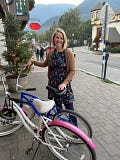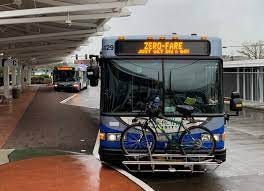Transportation Demand Management (TDM) does not get much attention, but its role directly effects how livable and thriving a city may be.
So what exactly is it?
TDM is using the existing infrastructure in more efficient ways. Like reducing single occupancy vehicle trips and getting people on transit, bikes, or in carpools.
It is about influencing people’s behavior to use the existing built environment better. (mobilitylabs.org)
To get a better understanding, we caught up with Veronica, who works for the Thurston Regional Planning Council in Washington, to see how TDM works within cities.
Her territory covers Thurston County which includes Olympia and the surrounding towns of Lacey and Tumwater, and she is responsible for coordinating transportation planning between each jurisdiction, to make sure infrastructure projects don’t conflict and people are able to get around.
She is also in charge of encouraging people to lessen their reliance on “single occupancy vehicles” (SOV for short) and commute by public transit, bike, carpools, vanpools, or just walking.
Olympia is an interesting city to pay attention to because it is quite progressive in terms of public transportation.
At the beginning of 2020, Olympia implemented zero-fare public transportation, and encourages people to just get on and go. A major step in reducing the friction in using the existing built transit system.
Veronica also pointed that her transportation department took another step in the right direction this year, shifting its focus from a car-centric perspective to a people-centric perspective.
In all transportation projects for all of time so far, we’ve talked about how to get cars through most efficiently, and now what we want to shift the conversation to is how do we get people, just people, through most efficiently. How to make people the most safe, all across the whole system. How are we thinking about all of them and not just cars.
We just have a car-centric planning and transportation system that we need to peel back so many layers on how we’ve done things, and how we need to change doing things.
This shift allows Veronica and her colleagues to see things holistically and find solutions for people to get around using all modes of commuting.
Such as biking.
Biking is pretty big up in the Pacific Northwest already, but a quick look at the numbers will tell you that still below 1% commute to work by bike. More than plenty of room to grow.
This year in May, Veronica joined hundreds in the community in a local cycling challenge to only bike to work for the whole month.
Lots of prizes were given out. Veronica won bike lights, and the grand prize winner received a $4500 gift card for tours offered by Adventure Cycling. Which is awesome. Both because it is fun, and because it shows skeptics that it can be done.
This challenge was not a stand-alone event. It is part of a wider initiative to reduce dependence on single-occupancy vehicles through gamification.
And I think that is brilliant.
Veronica actively works to get local employers on board to these programs and incentivize their employees to forgo SOVs and use alternative transportation.
A few examples:
One company gives you $2 for each day you don’t drive to work.
Another company pools the money, and puts your name in a raffle if you don’t drive all week to win cool prizes.
Some companies pay for Vanpools, so you get picked up and dropped off for free.
These incentives are supported by the transportation department, so there is little barrier for local businesses to want to take part.
Her team evaluates the usage and effectiveness of these programs bi-yearly, and then adjusts strategies to make sure the program is growing.
Bike commuting is not something new to Veronica.
She’s been into cycling since college, so making the switch from commuting by to car to by bike isn’t a big leap. But to others, it can be a much bigger leap. And people are not always eager to make.
But a month ago, Veronica stumbled upon (rolled upon?) something that is a gamechanger… She got an e-bike
This fixes all the problems people complain about with regular biking.
She had wanted one for a while, but like most people, the price tag was high, and she already had 3 bikes… until she got it, it just didn’t seem like anything special.
But it didn’t take long before she realized how great it was.
Trips to the store are faster on the ebike than in the car. And riding to work, it allows her to stay in the traffic flow better and helps make her feel a little bit safer than on a regular bike.
She’s quickly becoming an evangelist, and already has talked a couple friends into getting one for themselves…which tracks.
Getting people to start using different modes of transportation is kind of in her job description.
It’s just about winter at the time of writing this, but I imagine by next spring when the local bike challenge comes around, Veronica will have many more friend join her on an e-bike.
There are other interesting changes that Veronica is seeing in her work.
Before the pandemic, only around 5% of people worked from home. Commuters were driving to and from the office as normal, and Olympia’s infrastructure was experiencing stress, as a growing city expects.
Projects to construct freeway interchanges to keep cars moving through efficiently were on the table. And these projects were going to cost billions.
Then the lockdowns came, and traffic was no longer an issue. Everyone worked from home. There was no more daily commutes to the office. Those plans to build new interchanges were scrapped. They just weren’t needed.
Today, around 60% of workers in Thurston still work from home. Even as things are back to normal, traffic is not stressing the system. Which gives those in TDM an opportunity to continue their work getting people to commute by bike or by transit.
Bike lanes are not very extensive in Thurston County, but multi-use paths are a good way for bikes to ride safely. The problem is in what those in transportation refer to as first-and-last connections.
When you come to the end of a long multi-use path, you might be dropped at an intersection where people still don’t feel very safe… which is what commuters cited as the main reason they don’t choose biking.
These are some of the challenges that Veronica and others in TDM face.
Safety is a big issue. People feel safe in their own car, but when on foot or bike at a major intersection, they feel vulnerable.
Public education around pedestrian and pedalestrian safety is a growing need as people use alternative ways to get to work or run errands. Hopefully more cities take an active stance on encouraging active transportation like they are in Thurston County.
Our goal with Popcycle is to get more people to use e-bikes in their daily life. We have seen how much of an improvement it has on people’s mood and happiness. And talking with Veronica, we can see how important active transportation in on city planning and budgets.
Which gives us hope! Her department is already shifting its focus to a people-first mindset as it concerns local transit, and others will follow.
There are too many benefits to ignore.









Veronica & a Gamechanger for TDM